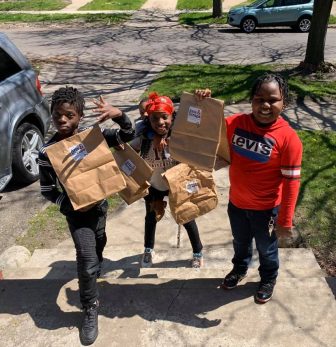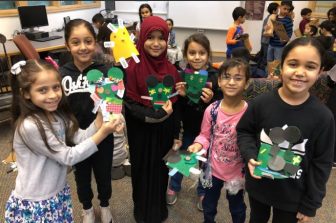
Kids create art from pre-packaged kits that include a variety of materials. IMAGE: Arts and Scraps
By Genevieve Fox
A Detroit organization is giving recycled materials a new life, one art project at a time.
Arts and Scraps, a nonprofit group that opened in 1989, reuses materials to empower people and teach science through art, said Executive Director Ang Adamiak.
“It’s kind of like a thrift store for creative materials,” Adamiak said.
Dana Robinson, an instructor and material coordinator at Arts and Scraps and a former teacher, has taught at the organization for about 10 years.
“This is the most rewarding experience,” Robinson said. “The most instant gratification I’ve ever had in all the things I’ve done in my career.”
According to the EPA, the 146 million tons of waste landfilled in the US in 2018 continues to rise.
The Arts and Scraps project saves an average of 20 to 30 tons of recycled materials a year. The most popular materials are yarn, fabric and an automotive sealing and cushioning material typically placed between two surfaces joined by bolts.
The materials have to be safe for 3-year-olds, clean and cool looking, Adamiak said.
Community members and local industries donate materials. Arts and Scraps collects them or donors bring them to their building in East Detroit.
Companies as far away as California and New York ship them materials, Adamiak said.

The Arts and Scraps Mobile travels to schools throughout Michigan where students can fill up a bag with materials to create art pieces. IMAGE: Arts and Scraps
The effort diverts things from landfills while creating less need for creating new things, Adamiak said.
But the organization is small. A small non-profit has one million dollars of revenue. Arts and Scraps is half of that, Adamiak said.
Finding sponsors to offer free programs for the community is challenging, she said. It’s also really hard to keep everyone employed and making a living wage.
The organization is unable to find as many volunteers as it did before the COVID-19 pandemic.
“We used to work with about 300 volunteers a week,” Adamiak said. “Now it’s about 25 a week.”
They now allow remote volunteers. People can pick up materials and process them in their own spaces.
The organization teaches kids at its brick and mortar building or travels to communities with a bus filled with recycled materials. They go to schools and other non-profit organizations with pre-packaged learning kits for students to learn and create art.
Most programs are provided by the Arts and Scraps Mobile because of the COVID-19 pandemic, Adamiak said.
In Michigan alone, there are four creative reuse organizations. Arts and Scraps is the only one that puts art and science education together, Adamiak said.
Other creative reuse centers like The District in Indiana and ArtStart in Minnesota combine art and science education. But most centers in the US don’t put them together, she said.
Last year Arts and Scraps taught over 17,000 Michigan students.
They learn about the 4 R’s – reuse, reduce, recycle and refuse – where the materials come from and what creative reuse means. They also study STEM – short for science, technology, engineering and mathematics.
The organization centers on the state and national curriculum that is taught to students aged five through 12, Adamiak said. After they pick a topic connected to STEM, they create a challenge using scraps. They then used inquiry-based learning where students explore topics through their own ideas while creating art.
It is a fun experience for the kids because they learn about a lot of things without realizing it, Robinson said.
“I know it works, and I know it’s a wonderful experience,” he said.
For example, a class called “Fish in the Detroit River” teaches students what an invasive species is and how it affects the river. Then the students create a fish from scrap materials and decide if it’s a friend or foe of the river, Adamiak said.
Another class called “Friends of the Earth” teaches students to clean the air, soil or water by taking shorter showers and putting plastic bottles in the recycling instead of the trashcan. The students realize that a friend to the Earth helps life as diverse as their mom and a whale, Adamiak said.
The point is to build a model out of scraps to remind them how to be good to the Earth, Robinson said.
“I tell the students my model is a gym shoe,” Robinson said. “That’s what reminds me to jump in my gym shoes instead of a car if I need to go to a store that’s less than a quarter mile away from my home.”
The group teaches students about what is happening in their own neighborhood, like how the Detroit incinerator affects their health and the health of their neighbors, Adamiak said.
By teaching students about things in the real world, the group hopes to make them passionate about something like engineering so they will make an impact in this world, Robinson said.
Students can make a great impact on the world through their creative ideas and small actions, Adamiak said.
Children deserve to know these things and to be a part of the collective action for change, Adamiak said.

Students holding up their art models they made in Friends of the Earth class. IMAGE: Arts and Scraps
Arts and Scraps has never received an environmental grant, Adamiak said. Most environmental grants are geared towards conservation.
“Some people don’t see reuse as the best way to solve the climate crisis, so that’s not where the dollars go,” she said. “Being a mesh of three different focuses, environmentalism, education/creativity and community can sometimes help us and sometimes hurt us.”
Adamiak seeks grants to collect more materials and add more environmental classes.
Arts and Scraps is also a community hub that attracts people of different ages, races and abilities.
“I have people tell me, ‘Oh my gosh, I remember you came to my class 20 years ago and I still remember learning about invasive species,’” Adamiak said.
Creative reuse sectors are part of a growing trend.
“My daughter can’t wait to take my granddaughter or granddaughters to Arts and Scraps and introduce them to that experience,” Robinson said.
I hope people realize that creative reuse can solve many more problems than we think, Adamiak said.
“Arts and Scraps exists because thousands of people come together every year,” she said. “Whether that’s bringing in their donations or donating their time or donating their money or being part of a class or shopping at our store.”
The group next wants to push for more recognition of the creative reuse sector, Adamiak said.